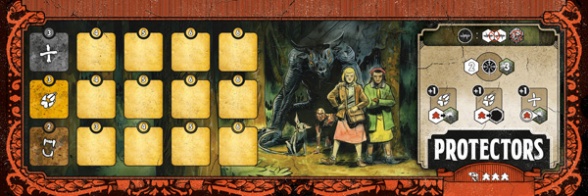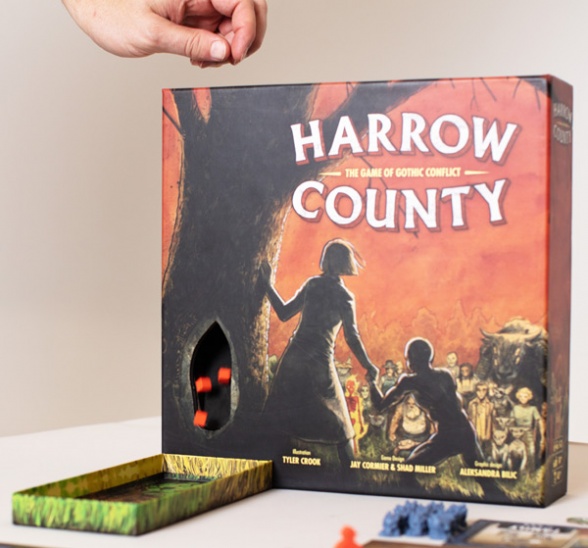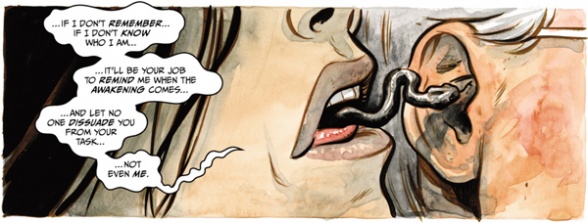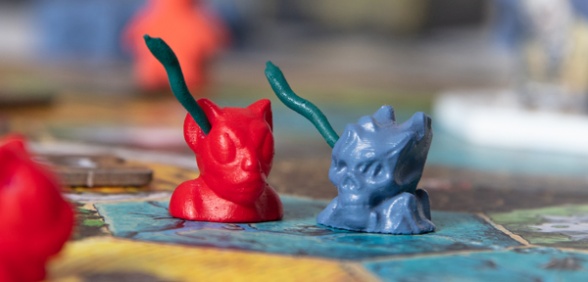
Welcome to the Harrow County Observer, Multiversity Comics’ dedicated “Harrow County” column. In the latest installment we’re looking at the “Harrow County” board game from Off the page Games. In case you didn’t know, the Kickstarter launched today and we couldn’t resist to the opportunity to talk to the game’s creators, Jay Cormier and Shad Miller, as well as the comic’s creators Cullen Bunn and Tyler Crook. Keep in mind that if you haven’t read the first two arcs of “Tales from Harrow County,” there are some spoilers ahead.
I’m curious, how did conversations begin for making a “Harrow County” board game?

I actually pitched it to Chris Schweizer, since I adore his art, and thought maybe he would be interested in writing a new comic based on this universe of Skirmishes. He liked the game but admitted he was swamped with work already. He was the one who thought of the connection to Harrow County. I hadn’t read it yet, so I quickly devoured the entire series and Shad and I could definitely see it working in that world. We set up a meeting with Cullen and Tyler and pitched what we had then, and asked them to imagine more “Harrow County” goodness draped all over it. Maybe it was because of the success of MIND MGMT—or at least how much care and passion we had for the source material—but they said yes!
We spent the next two years re-envisioning the game so that it felt like it belonged in Harrow County. The game immediately became asymmetric and it even allowed us to go from a two player-only game up to a four player game!
Tyler Crook: Aw, wow! I actually didn’t know that Schweizer pointed you at us! That guy is the best!
Shad Miller: I remember that it started with a text about Castle Hunting in Switzerland. The next thing I knew, I was having an extraordinary adventure pitching Skirmishes at Essen, trailing Jay, and meeting some fantastic game designers. All of that finally culminated in a meeting with Tyler and Cullen, where I experienced feeling star-struck for only the second time in my life.
Jay had told me about his idea to become a publisher who championed creator-owned comics and made games for them. I thought, “Wow, that’s just a great thing to have to happen in the world,” and now that I’m part of it and seeing it in action, I couldn’t feel more passionately about that mission or more excited to get to work with amazing people like Tyler and Cullen.
Cullen Bunn: I’m a big board game fan, and I’ve long wanted to see some of my comics adapted to that format. I’m probably remembering this ALL wrong, but I want to say Jay and I spoke several (several!) years ago, before Off the Page was a thing, about an adaptation of “The Sixth Gun.” Early stage conversations. I know I met Jay at a GenCon at some point, but these days things just seem to run together. Whether that meeting was reality or a fever dream, I’m glad we’re able to work together now to bring this Harrow County game into the world.

What was your starting point on Harrow County: The Game of Gothic Conflict. How did you lock in on the right kind of game for this story?
Jay: Once we realized that our existing game was going to be turned into a game set in Harrow County, we started to identify the key pillars of the comic. What would NEED to be in a game based on the “Harrow County” comic series? What would you expect to be in this game? This is what led us to our first two factions—Emmy and her friends (who we ended up calling the Protectors) and the Family. Immediately we knew that we couldn’t keep the symmetry we had before because they both have different goals in the comic. The Protectors want to save Harrow County, while the Family wants to destroy it and start over. So then we had to figure out, in the system we had then, what would that look like? How could we save Harrow County? How could we destroy it? We ended up with a unique system for each faction that worked well together.



That’s really cool the way you use the mechanics to reflect character. And as I understand it, Hester Beck has a big impact on the way the game’s played too.
Shad: Hester was a must, but she couldn’t be there at the start. She also couldn’t upset the balance of the two-player game, but she had to be a real threat. Where we’ve ended up leaves me breathless, like Hester hanging from the tree. She plays the factions against each other, just like in the comics, but when she’s loose, you better run. The tree was like a flash of witch’s fire when we thought of it too, and the variability and surprise that using it for combat, and for Hester, adds is one of my favorite parts of our game.
Jay: When we batted around some ideas of how we could include Hester—who’s dead and buried under the tree—we came up with a cool concept: Hester could control the roots of the tree. We asked Cullen and Tyler if they would allow us some liberties with how Hester infects people and limited it to only hexes where she has a root. They were both gung ho because the concept was so bonkers.

When Hester first started appearing in our playtests, she was only ever the roots with the goal of coming back to life by the end. This felt anticlimactic though. We wanted to have Hester appear DURING the game and for players to be scared of her. What did Hester want to do in the comic? Well, she wanted to consume the others and so we did the same here and turned that into her objective: consume enough to regain enough strength. It was very cool but it soon made us aware of a huge issue in 3-player games that have combat: two players could gang up on one and make it nigh impossible for that player to compete. We were able to solve it in two similar ways. We said that in order to summon Hester you need a bonfire. The way you get a bonfire is by bringing together an infected haint from each of the other 2 players. This ensured that you couldn’t spend your time constantly infecting one player. Then once you had a bonfire, you could try to summon Hester. Finally Hester then had to consume 3 tokens (actually remove tokens) from each of the other 2 factions. This again ensured that she couldn’t gang up on just one player. This was the magic formula to ensure that players might have temporary alliances, but they wouldn’t last very long!
Continued belowShad: I was also thrilled when we thought of putting the tree cube tower in the box because it reminded me of how Tyler always hid the “Harrow County” title in the mud or sky of the opening splash pages in the comic. Harrow County’s subtle magic adds to everything it touches, and our game is no exception.
Hester’s hanging tree is such a huge part of the comic, and I thought the idea of creating a cube tower out of the game’s packaging was truly inspired. It’s also such a clever way to focus on Tyler Crook’s art. For our readers who are unfamiliar, could you explain what the Tree cube tower is and how it’s incorporated into the packaging?

Jay: While I have about twenty published games to my name, this is actually the first game I’ve designed that has combat! That meant I had a lot of learning to do. Our first version of this game had deterministic combat. This is kind of like chess—when you move onto a space with an opponent’s piece, you win the combat. We felt like it really lacked emotion and made the game too puzzley. So then we went to dice. We tried all sorts of different ways dice could be used, but we found we also had to design ways to mitigate the swingy-ness that dice have. It felt like there were too many rules getting in the way just to ensure combat was emotional but fair.
Then we came across the idea of a cube tower. I had played Amerigo and loved how it was used as a way to decide which action you want to take in a turn. I hadn’t played Wallenstein or Shogun but thought we could use it for combat in Harrow County. A cube tower is a cardboard chute that has all these ledges and holes on the inside of the tower. This means that when you throw cubes in, some cubes will get stuck on a ledge and some will flow through, thus randomizing the result.
While we definitely played around with many different ways on how to process the cubes that fall out, we immediately knew that the cube tower was a keeper. It’s just such a great balancer! If one player is winning battles, then they’re spending cubes while their opponent is not, which leaves the door open for a big counterattack in the next turn!
Right around this time I was trying to think of what the cover could look like and we knew immediately that the tree had to be on the cover since it’s so pivotal to the story. It got me thinking…is there a way to make the cube tower so that it was integrated into the game box? The hole that the cubes would fall out would be the hole that Emmy was born out of, so it seemed like a perfect fit! I was excited and thought up a way to do it and recruited Daniel Cunningham—who’s just a genius when it comes to inserts and things like this—and he was able to make an actual version of this that worked. We tweaked it, had a sample made from my manufacturer in China, and tweaked it some more until we have the almost final version we have in our samples we sent out to reviewers. (Almost final as there are still a few tweaks we can do to improve cube flow!)
Shad: The box idea was just incredible. We had been thinking of the tree as the tower, but couldn’t see it, then boom! I couldn’t believe the speed when Jay sent me a picture of the prototype. I also love that it mimics the way that Tyler is always hiding surprises in his art, like the title of Harrow County in the environment art he does. I like how the tree builds tension and how the tower’s caught cubes conceal the players’ power. For me, it was an attempt to remind the player of all the adept foreshadowing that Cullen does in his writing and how there is always more hidden than apparent in Harrow County comics.
Continued below
It’s cool how you’ve not just tried to capture the spirit of the “Harrow County” comic in this game, but you’ve even gone so far as to involve the creators beyond just consulting with them. You’ve got Tyler Crook creating new art for the game and Cullen Bunn writing flavor text for cards. For “Harrow County” fans, that makes this feel so incredibly authentic.
Shad: They have given us so much insight every time we met with them, and right after we started making Harrow County, Jay and I could not believe how naturally the design decisions came. Who would the third player be? Of course, it had to be Hester, and she had to control the tree. And once Cullen started naming cards, more ideas came, and more cool combinations came to us. Reading the comics and talking about them repeatedly, Jay and I couldn’t stop pinging one another with new exciting Harrow County-inspired mechanics and ways that Harrow County cleared up challenging design decisions.
Jay: It’s one of the reasons why I love my company! I get to work with some of my comic book heroes! Also, the game is just so much better than I could have ever imagined on my own. Surround yourself with creative people and you end up with a product that is more than one person could have ever thought up.
Cullen: From the beginning, Tyler and I have been very involved in the development of the game. When we went into our first meeting, I was hesitant, only because I was so dead set that any game set in this world had to FEEL like it belonged. From the jump, my reservations were dashed, because it was clear that this wasn’t just going to be an adaptation in name only. They were open to our ideas and suggestions to improve the game and bake more and more of Harrow County right into the mix. It’s been such a rewarding experience.
Tyler: I think the gameplay meshes with the story partially because there are a LOT of characters and creatures in Harrow County. But it’s mostly just the creativity of Jay and Shad finding the connections and putting it all together in an amazing way.
How did you find the prospect of creating new art for the game?
Tyler: I think the most exciting part for me was making the 3D sculpts for some of the game pieces. In spite of having worked in video games for years, I never had the opportunity to make a 3D model that would be physically manufactured. I really got a kick out of that part.
From what I’ve seen of the game so far, you have sculpts of various haints for the different factions. Haints, of course, are a huge part of the “Harrow County” comic, so they had to be a big part of the game. I particularly love that you added a slot for a snake to go into the haints’ ears. It’s such a cool detail from the comic and it sounds like a fun mechanic for the game too.

Jay: For the longest time we were just going to use different coloured meeples for the haints of each faction. But once we knew we wanted the snake to go into the ear, we had to do some pricing from our manufacturer. If we made them out of wood, then the hole would be inconsistent from meeple to meeple and I didn’t like that. You wouldn’t want a chance that a snake couldn’t actually fit into one of the meeple’s ears! So then we knew we had to go plastic, and once you’re doing plastic, a sculpt is the same price as a mini (assuming they’re the same mass, which they are in this case), so we decided to give every edition these cool individualized sculpts for each haint!

Shad: This was a particularly cool brainstorm too, and definitely one of our favorite features of the game. I find that people first notice the tree and are really interested in the snakes after. One thing I love about this along with the resonance with the comics is that it gets them excited to get to Hester even if they haven’t read the comic.
Continued belowYou also have an expansion planned, which is going to be pulling from some of the latest “Tales from Harrow County” stories, introducing the Fair Folk. I’m particularly excited about this, because it’s an aspect of “Harrow County” that’s still very new to readers, so playing with this faction becomes another way to learn about them.
Cullen: I love how this game capitalizes on all the intricacies of the comic! And, yes, I can’t wait to see the Fair Folk. We’ve talked a lot about how they would work in the game. It’s particularly cool in that every addition to the game works in its own unique way that is true to the world. Hmm. Now that we have the Fair Folk, could the City Cousins be far behind?
Jay: Oh Cullen—don’t tempt us!!! We were designing the main game when the ‘Fair Folk’ comics were hitting the stands and we were immediately attracted to the idea of including them somehow. It felt like such a board game mechanic with the Fair Folk needing to bargain with others to get them to do things for them. Then we had to figure out how to do it. In the comic the Fair Folk are looking for their missing Queen, her crown, and her sword. We came up with this cool concept where the Fair Folk get a small turn after each of the other players take a turn. They place offers out on the board, and if another player is tempted and moves onto a hex with an offer, then they also have to give a piece of information about where the Queen’s sword, crown, or the Queen herself is located.
Oh, wow. That adds such a different dimension to the game.
Shad: One of my favorite aspects of where we’ve gotten the game is that players in very different moods can enjoy this game. If you’re feeling like playing a game with a lot of bargaining and social negotiation, the Fair Folk are great! I often feel like playing exactly that and most days they are my favorite faction to play. If you like bag drafting or changing the board you can play the family, if you feel like building your faction up to match your strategy and adapt to your opponent while surprising them you’ll love the Protectors, and if you want a puzzly engine builder Hester will delight and frighten you with her power. It’s also great that you can play the Fair Folk with or without Hester and with any combination of the Protectors, Kammi, and the Family. Of course my favorite part of designing each of these factions’ powers was the process of connecting them to the comic.
Harrow County: The Game of Gothic Conflict Kickstarter is now on and will run till October 27th. You can also follow along with the campaign through Off the Page Games’ Facebook page, Twitter, and YouTube channel.






